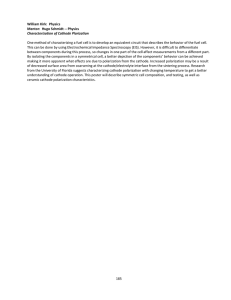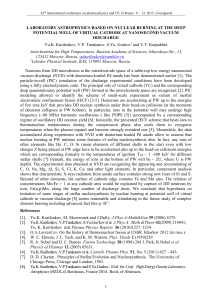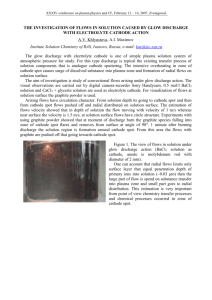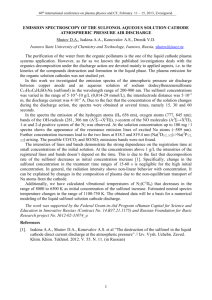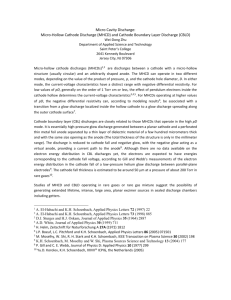Cathode Material Change after Deuterium Glow Discharge Experiments
advertisement
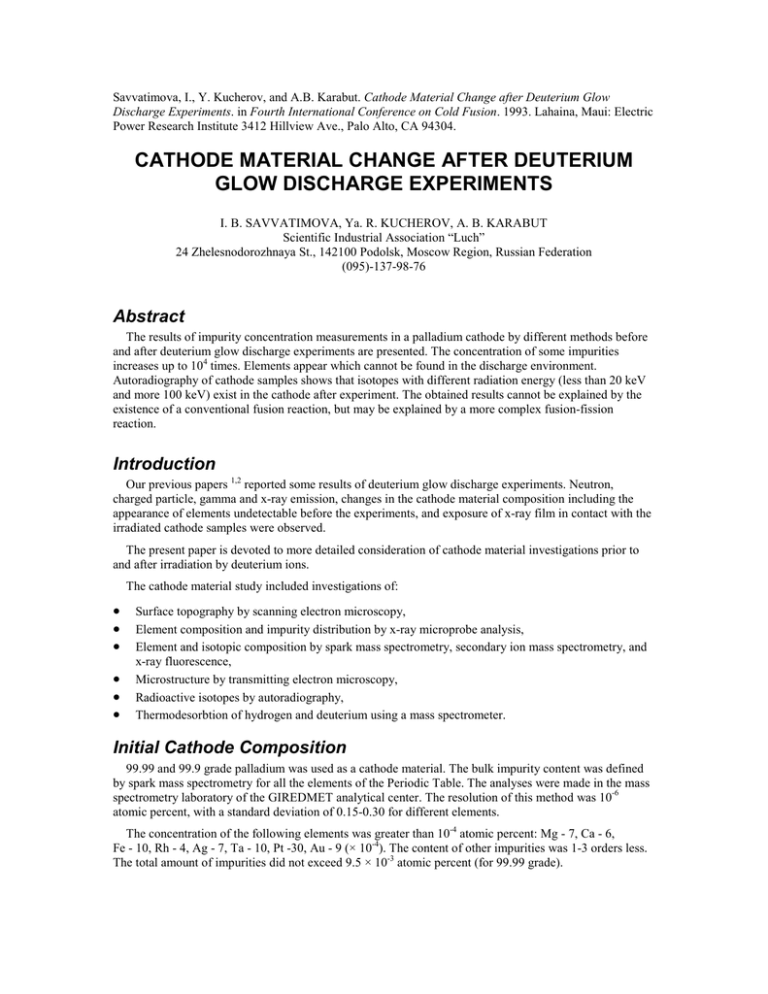
Savvatimova, I., Y. Kucherov, and A.B. Karabut. Cathode Material Change after Deuterium Glow Discharge Experiments. in Fourth International Conference on Cold Fusion. 1993. Lahaina, Maui: Electric Power Research Institute 3412 Hillview Ave., Palo Alto, CA 94304. CATHODE MATERIAL CHANGE AFTER DEUTERIUM GLOW DISCHARGE EXPERIMENTS I. B. SAVVATIMOVA, Ya. R. KUCHEROV, A. B. KARABUT Sc i e n t i f i cI n du s t r i a lAs s oc i a t i on“ Lu c h ” 24 Zhelesnodorozhnaya St., 142100 Podolsk, Moscow Region, Russian Federation (095)-137-98-76 Abstract The results of impurity concentration measurements in a palladium cathode by different methods before and after deuterium glow discharge experiments are presented. The concentration of some impurities increases up to 104 times. Elements appear which cannot be found in the discharge environment. Autoradiography of cathode samples shows that isotopes with different radiation energy (less than 20 keV and more 100 keV) exist in the cathode after experiment. The obtained results cannot be explained by the existence of a conventional fusion reaction, but may be explained by a more complex fusion-fission reaction. Introduction Our previous papers 1,2 reported some results of deuterium glow discharge experiments. Neutron, charged particle, gamma and x-ray emission, changes in the cathode material composition including the appearance of elements undetectable before the experiments, and exposure of x-ray film in contact with the irradiated cathode samples were observed. The present paper is devoted to more detailed consideration of cathode material investigations prior to and after irradiation by deuterium ions. The cathode material study included investigations of: Surface topography by scanning electron microscopy, Element composition and impurity distribution by x-ray microprobe analysis, Element and isotopic composition by spark mass spectrometry, secondary ion mass spectrometry, and x-ray fluorescence, Microstructure by transmitting electron microscopy, Radioactive isotopes by autoradiography, Thermodesorbtion of hydrogen and deuterium using a mass spectrometer. Initial Cathode Composition 99.99 and 99.9 grade palladium was used as a cathode material. The bulk impurity content was defined by spark mass spectrometry for all the elements of the Periodic Table. The analyses were made in the mass spectrometry laboratory of the GIREDMET analytical center. The resolution of this method was 10-6 atomic percent, with a standard deviation of 0.15-0.30 for different elements. The concentration of the following elements was greater than 10-4 atomic percent: Mg - 7, Ca - 6, Fe - 10, Rh - 4, Ag - 7, Ta - 10, Pt -30, Au - 9 (× 10-4). The content of other impurities was 1-3 orders less. The total amount of impurities did not exceed 9.5 × 10-3 atomic percent (for 99.99 grade). Surface Topography and Change in Elemental and Isotopic Composition of Cathode Material A significant change of the surface topography is observed in the irradiated zone of the cathode samples including formation of various spikes, more pronounced on the border between irradiated and shielded zones. Under certain discharge conditions, spikes having a predominantly conical shape are formed on a large scale. The elemental and isotopic composition of cathode material was analyzed by various methods in more than ten laboratories. Impurities in the discharge environment were also investigated, because of the possibility of mass transport to the cathode from the molybdenum anode or insulators (silica or alumina). X-ray microprobe analysis of representative areas on the front of the sample (irradiated and shielded), on the backside and in the section perpendicular to the front side was made before and after experiments. The spatial resolution was about 1 micron. The thickness of analyzed layer was 1 micron. The Pd cathode samples after experiments show that the content of the some elements increases from tens to hundreds of times. In the analyzed layer, the content of elements undetectable by microprobe analysis before experiments increases up to 0.5 atomic percent. The results of the microprobe analysis for two cathodes are presented in the Table 1.These elements were not found in the initial sample by the microprobe analysis. The content of the impurities in Pd cathodes varies after other experiments. Table 1. Impurities in the Pd after experiments of different duration (X-ray microprobe analysis, A. Se nc huc ov“Lut c h”) Impurity content, 10-2 at % Atomic After 4 hours After 40 hours Element number exp. exp. Na 11 7±0.3 3±0.3 Mg 12 1±0.3 2±0.3 Al 13 4±0.3 2±0.3 Si 14 1.5±0.3 <0.3 Ca 20 4±0.3 3±0.3 Τι 22 1±0.3 1.5±0.3 Br 35 3±0.6 2±0.6 Sr 38 7±0.6 6±0.6 Υ 39 40±1 20±1 Mo 42 15±1 40±1 Tc 43 20±1 10±1 The characteristic x-ray spectrums of samples show maximums corresponding to Zn, Br, Ca, for which initial concentrations measured by spark mass spectrometry were 10-4, 10-3 and 10-6 atomic percent respectively. The impurity distribution over the cathode surface measured by microprobe analysis appeared nonuniform. The comparison of the distribution (Fig. 2) with SEM photos (Fig. 1) shows that impurities are localized along crystalline subgrain boundaries. The impurity segregation point density is about (1-10)×1010 for example: (1-2)×1010 m-2 for Zn and (24)×1010 m-2 for Br). Density of all segregation points containing Mg, Co, Zn, Br is about 1011 m-2 for Br (Fig. 3a). With changing experimental conditions and initial content, the set of the observed elements also changes. A significant increase in Mo and Nb impurity content was registered by x-ray fluorescence (B. M. Ku di n ov ’ sg r ou p,GI REDMET) . Th ede t e c t i ont h r e s h ol doft h eme t h odwa s(2-5)×1016 atom/cm2. The upper 20-25 μlayer was analyzed. Assuming that Nb and Mo impurities are distributed uniformly in 100 μ sample, their content would amount up to 0.07 and 0.08 mass percent respectively. The real quantity of the Mo and Nb was observed 1.5×1017 and 1×1017 at/vm2 respectably. But they were not found on the back side of the sample. Thus, assuming that Mo and Nb impurities exist only in upper 1 μlayer their content would amount to about 0.5 mass percent. Mo is present in the discharge environment, but Nb is not. For the first time, deviations from natural isotope ratios for impurities in the palladium cathode after our experiments were found by secondary ion mass spectrometry i nI .P. Ch e r n ov’ sg r ou p( Toms k Polytechnic Institute). Changes in the isotopic ratio for some elements are presented in Table 2. The change of elemental composition was also observed by spark mass spectrometry in the Testing An a l y t i c a lCe n t e rGI REDMET( G.G.Gl a v i n’ sl a bor a t or y ) ,t h eu ppe rl a y e rwi t ht hi c kn e s soft e nsof microns was analyzed. It has been found that the increase of individual element content ranges from 10 to 104 times (for Ti, Nb, Zr, Ag, Rb, Yn, Mo). Results of this analysis for two experiments of different durations are presented in Table 3. It should be noted that we observed an increase in the same elements in the underlying sample. As shown in the Table 3 increasing for Li, Si ,ΑΙ ,Κ,Se, Ti, Nb, Mo, Ag, Br, Rh, Yn was about 3-10 times and more (especially In a four hour experiment). It can also be seen that the isotope ratio changes for some elements. The isotope ratio increases for 6Li/7Li - 2-10, 13C/12C -10, 41K/39K -2, 44Ca/40Ca ~4-2, 9lZr/90Zr -2 times in the different experiments. Fig. 1. Surface topography of the palladium sample after experiment (irradiated zone) Fig, 2. Some impurities distribution on this Pd surface. Table 2. Change of isotopic composition of pd cathode after deuterium glow discharge experiments (secondary ion mass-spectrometry; on a per unit basis) Initial Front side Back side Mass Element Initial Front side Back side Mass Element before exp, after exp. after exp. 6 Li 0.02 1.00 0.15 7 Li 0.02 9.00 0.28 10 Β 0.01 0.01 0.01 11 Β 0.1 7.00 0.05 51 V 0.3 10.0 0.2 53 Cr 0.6 30.0 1.0 54 Fe 2.2 15.0 2.0 before exp. after exp. after exp. 60 Ni 0.1 3.0 0.2 61 Ni 0.2 10 0.2 63 Cu 1.4 60 1.0 87 Sr 0.1 1.0 0.1 88 Sr 0.5 0.1 0.2 90 Zr 0.0 57.0 0.0 91 Zr 0.1 34.0 0.1 56 Fe 22.2 55.0 20.0 57 Fe 11.0 45.0 12.5 Table 3. Impurities in the Pd after experiments of different duration discharge experiments (by spark mass-spectrometry) Mass Element Initial Impurity content increase, times content After 40 hours of experiment After 4 hours of experiment ppm* Irradiated Underlying (upper), sample sample irradiated Underlying (upper), sample sample 2.5 6.5 11 5 3 7 25-50 2-10 13 4 0.3 1.5 11 0.3 1.5 3 6 Li 0.06 7 Li 0.08 10 Β 0.07 11 Β 0.07 23 Na 0.44 27 Al 6 28 Si 9 29 Si 7 30 Si 6 32 S 7 39 j Κ 3 41 Κ 3 47 Ti 1.2 48 Ti 1.4 49 Ti 1.3 50 Ti 1.7 78 Se 0.23 80 Se 0.3 85 Rb <0.03 90 Zr <0.05 91 Zr <0.05 93 Nb <2 98 Mo 0.4 100 Mo 1,8 103 Rh 7 107 Ag 1 109 Ag 1 115 In <0.04 * standard deviation is .15-0.30 4 10 15 2 3 3 0.5-2 3 4 4.5 2 3 2.5 1.5 1 1.5 1.5 0.3 <1 0.7 <0.13 500 1000 20 0.3 1.5 1.5 2.5 2 <1 0.7 1.7 <0.1 <0.5 1 2500 <2-4 63 50 12 1 <2-4 3 1.5 1 370 357 3-4 0.5 4 5 43-60 100 65 <0.9 <0.5 3000 1200 1220 360 1600 5-2.3 1 20 2.5 2 16 11 1700 4.4 2 7.5 1 3.2 2.5 4 We can see in Table 3 that the impurity concentration does not depend on the duration of the experiment. Probably this means that the main change of the elemental composition was in the first hours of these experiments. Usually x-ray microprobe analysis (1 μanalyzed layer) gives greater or equal values of the impurity content than spark mass spectrometry (10-100 μ) . The results obtained by these methods for the same sample are presented in Table 4. A comparison of the results gives ground to the suggestion that possible nuclear reactions, producing impurity elements, occur in the narrow band of near surface layers. Table 4. Comparison of impurity content in the Pd cathode measured by two different methods Element Impurity content, ppm Spark mass X-ray microprobe spectrometry * Analysis Na 5.8±1 700±30 Mg 95±1 100±30 Al 500+300 400+30 Ca 35±8 400±30 Si 30±5 150±30 Ti 100±50 100±30 Br <0.5 300±60 Sr <2.5 700+60 Y 0.2±0.05 4000±100 Mo 3000±350 1500±100 Tc not detected 2000±100 * Deviation for different analyses Autoradiography Investigations Radioactive isotopes appearing in cathode materials after deuteron bombardment in our experiments were registered by autoradiography. For registration, autoradiographic film RT-1V was used. Two or three films were placed by each side of irradiated sample and fixed with rubber spacers in a box to prevent displacement of the sample and film. Then the box was hold isothermally in a refrigerator for a time from 2 up to 250 hours, After some experiments the films was replaced and developed every 2-8 hours during 48 hours. Considerable film exposure occurs from contact with irradiated samples. Light spots on positive images (Fig. 3, 4) resulted from exposure by radioactive isotopes. All six 100 μpalladium foils placed in cathode holder cause film exposure, though only upper foil was bombarded (Fig. 4a-c). This fact can possibly be explained by the production of tritium and other radioactive isotopes. The degree of exposure mainly depends on experimental conditions such as deuteron flux, irradiation temperature and site at the cathode sample. The degree of exposure increases with increasing run time and deuteron flux (for limited density flux). Under low density fluxes, exposure in the irradiated zone is greater than that in the shielded zone. Under high density deuteron fluxes, sputtering of cathode upper layers occur due to intense ion bombardment, and the discharge zone exposes the film to a lesser extent than the shielded zone does. Again, it may be supposed that isotopes formed during the experiment diffuse from the discharge zone (which is irradiated) to the cooler zone (shielded by the cathode holder). The formation of isotopes with different radiation energies is observed. The energy of radiation has been evaluated using an attenuating screen. Fig. 3a shows the scheme of energy measurements. A twenty micron film of (CF2)n was placed between a sample and two x-ray films so that it shielded half of the sample. The first x-ray film (next to the sample) demonstrates that the (CF2)n screen stops a considerable part of the radiation. The second film exhibits weak but uniform exposure all over the sample including outside the discharge areas. Thus, soft and hard components of radiation are observed. Soft components can be betas from tritium with energy <20 keV. Particles penetrating through (CF2)n film and 200 μx-ray film are equivalent to at least ~0.1-0.5 MeV betas. Assuming the low energy component as tritium betas, the activity of the Pd sample after deuterium glow discharge is estimated as 5×105-5×106 β/ (cm2s) and decreased to 103 b/(cm2s) after 200-2000 hours (Fig. 4d). Activity of the isotope(s) with high radiation energy was estimated as corresponding to 90Sr activity of ~(2-5)×104 β/ (cm2s) Structural Changes After deuteron bombardment at 200ºC the dislocation density increases and cellular dislocation structure with lesser cells is formed. The fragmented structure is supplemented with void formation mainly along fragment subgrains. The void density in the surface layer with the thickness ~10000 angstroms is 1020 m-3. Void sizes are to 1000-1500 angstroms. Isolated second phase inclusions with size up to 1500 angstroms can also be seen2. Void structure formation under ion bombardment is usually observed at higher homological temperatures, corresponding to much larger ion flux Void structure formation under ion bombardment is usually observed at higher homological temperatures, corresponding to much larger ion flux and fluence. This may be circumstantial evidence of nuclear reaction. Fig. 3. Scheme (a) of autoradiographic measurement: with films RT-iV (1, 2, 3), Pd sample and (CF2)n screen, (b) positive images from the films 1 and 2 for each side after radiography. Fig. 4 Autoradiography positive images of six underlying foils comprising cathode: a - sketch of the experiment, b - positive images for each palladium foil (see fig 5a, for both sides, c - activity vs. foil number (for both irradiated and shielded areas of each foil), d - activity vs. time after experiment. Table 5. 3He and 4He Content before and after Deuteron Bombardment (Rockwell International Laboratory) 3 Sample number material before irradiation 1497 1497 1504 1504 Sample Analyzed area mass, g 8.42 10.31 9.77 9.82 irradiated 1.90 2.12 shielded 11.11 12.25 irradiated 16.5 18.5 shielded 14.4 16.4 3 9 He×10 a/s ±σ 0.1±0.6 0.2±0.6 0.2±0.6 0.0±0.6 0.2±0.3 1.2-0.5 0.0-0.6 0.2-0.3 -0.4-1.3 1.0-0.5 0.3±0.6 0.0±0.2 He ratio after 4 exp. He×109a/s /before ±σ 0.3±0.3 0.6±0.3 0.2±0.5 0.1±0.5 1-10 1.8±0.2 >2 1.3±0.6 -0.2±0.3 -0.8±0.8 1-2 7.1 ±0.2 1-2 7.7±0.6 -0.3±0.3 4 -- -- 0.1±0.8 He ratio after exp. /before 9-100 4-90 --5-35 4-30 -- 3 He and 4He Content Some of the irradiated cathode foils together with reference samples were analyzed by mass s pe c t r ome t e rofRoc kwe l lI n t e r n a t i on a l( Ol i v e r ’ sg r ou p) .Th eh e lium content was determined both in irradiated and in shielded zones of cathode. Results of the study are summarized in Table 5. A small increase in the 3He concentration and a large increase in the 4He (4-100 times) concentration was found in the irradiated areas. Conclusions The following observations can be made after deuterium bombardment of Pd cathode in a glow discharge: 1. Increase of individual elements in the Pd cathodes up to 2-10000 times, depending on the experimental conditions of the irradiation by ions D and H. Greater changes have been observed after more intensive ion bombardment. 2. Change of the isotope ratio for individual elements up to 2-20 times for the following elements. The quantity of the each isotope may be different in different analyses zones. The difference may be about 75%. 3. Increase of the 4He content by 10-100 times. 4. Formation of the radioactive isotopes with low and high radiation energy (<20 keV and ~0.5 MeV) occurs in the irradiated cathode after deuterium glow discharge experiments (hydrogen and argon too). 5. Radioactivity of the cathode materials was observed after ion irradiation by H, D, Ar and other ions of the inert gases. Radioactivity was (1-7)×106 after experiments and <103 cm2s-1 after 20-200 hours. 6. Formation of the void structures in or near the surface of the palladium cathode. We a kr a di oa c t i v i t yoft h es a mpl ea n dl a r g ei mpu r i t yc on c e n t r a t i onma ybear e s u l tof“ c ol d”n u c l e a r products or transmutation. The results of the element and isotope change in cathode material do not contradict to the earlier suggestion 3 that the reason for the appearance of elements undetectable before the experiments is fusionfission nuclear reactions in the cathode. References 1.A.B.Ka r a bu t ,Ya .R.Ku c he r ov ,I .B. Sa v v a t i mov a“ Th eI n v e s t i g a tion of Deuterium Nuclear Fusion at Gl owDi s c h a r g ec a t h ode , ”Fusion Technology, 20, #4, part 2, 924, (1991). 2.A.B.Ka r a bu t ,Ya .R.Ku c he r ov ,I .B. Sa v v a t i mov a“ Nu c l e a rPr odu c tRa t i of orGl owDi s c h a r g ei n De u t e r i um. ”Physics Letters A 170,265, (1992). 3. A.B.Ka r a bu t ,Ya .R.Ku c he r ov ,I .B. Sa wa t i mov a“Pos s i bl eNu c l e a rRe a c t i onsMe c h a n i s msa tGl ow Di s c h a r a ei nDe ut e r i um. ”Fr on t i e r sofCol dFus i on ,Proc. of the third International Conf. on Cold Fusion, October 21-25, p. 165, Nagoya, Japan, university Academy Press, Inc., Tokyo, Japan, (1992)
